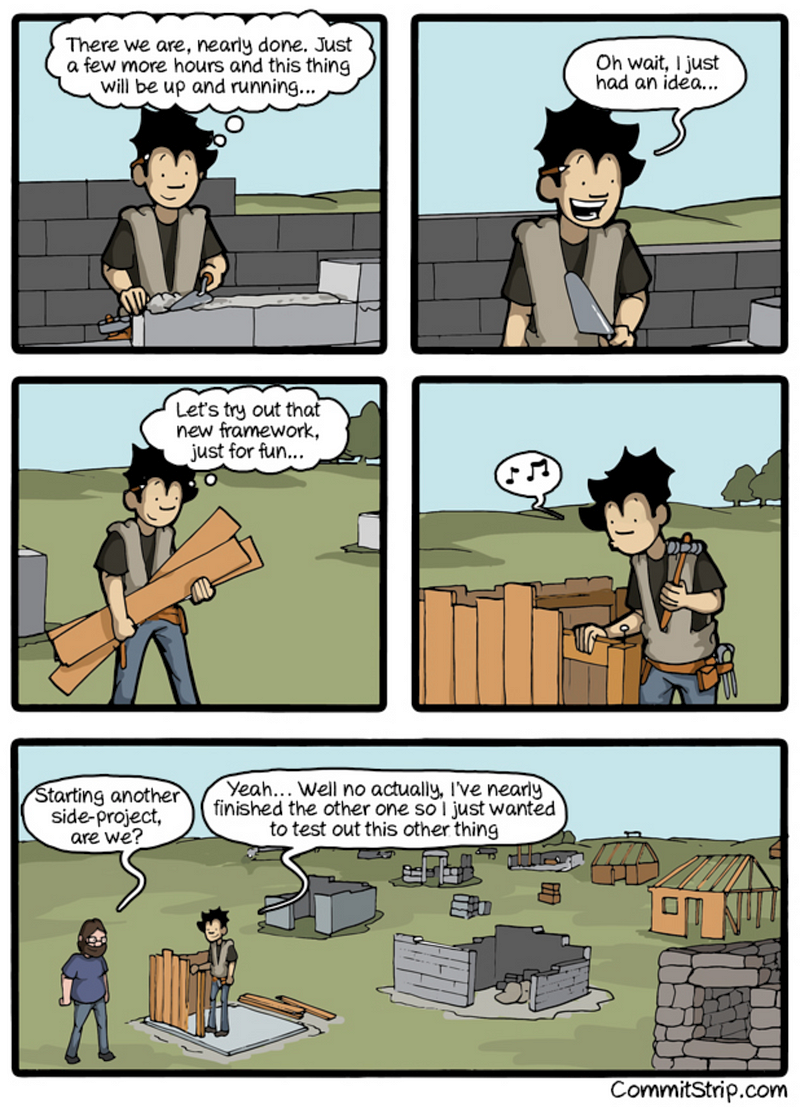5 Reasons Why Side-Projects Never Get Finished
Learn why side projects stall & get back on track! Overcome distractions, find passion, beat boredom, and prioritize effectively.

Are you a programmer?
Chances stand 9/10 that you have active side projects.
Have you published a side project?
You most likely didn’t
Why is that?
It seems like such a simple thing to do. You just have to keep working at it until you’re done, right? Apparently not.
The average developer spends more than 7 hours per week coding on the side. - StackOverflow
There are many reasons why even the most motivated people can’t seem to finish their project ideas, but the good news is that there are ways around this issue. If you are currently stuck in this situation, here are some tips on how to get back on track!
1. Shiny Object Syndrome
Shiny Object Syndrome is a term that describes the tendency to get distracted from one task by another quickly. Here’s how it plays out: You start on a project and get excited about what you’re doing — but after a few days or weeks, you realize that the project isn’t going anywhere fast (or maybe even at all). So, rather than doubling down and making progress on your project, you get discouraged and move on to something else — anything else!
Just like a small child chasing after shiny objects. Once they get there and see what the object is, they immediately lose interest and start chasing the next thing. For you, rather than literal shiny objects, shiny objects may be side-projects, technologies, or programming languages.

The Shiny Object Syndrom is particularly relevant for side projects because, as you might have noticed, there are many things we could be doing instead of working on them.
We can all get distracted with shiny new project ideas and as a result, abandon our current efforts. While some may intend to return to the project, it will likely lead to it becoming stale and remaining that way.
Having multiple projects can feel overwhelming. It’s difficult to focus on one thing when you have so many great ideas floating around in your brain.
“Focus is a matter of deciding what things you’re not going to do.“— John Carmack
A good way to prevent this from happening is by focusing on one project at a time.
It’s essential not only as side project owners but also as creative people in general: If we don’t stay focused on our goals and priorities, we’ll never achieve them!
2. You’re Not Doing What You Love
“If you do what you love, you’ll never work a day in your life.“ - Marc Anthony
Why is it important to do what you love?
When you do something that you’re passionate about, it becomes easier, more fun, and less stressful. Often you are entering a flow state which gives you momentum where all tasks feel effortless and easy to do.
The state of flow is a psychological term for being completely immersed in what you are doing. When you are in the moment, focused on the task at hand and not thinking about anything else. You lose track of time and feel like you could do that activity forever because it feels so good.
As a programmer, you most likely experienced a “Flow”. You lose track of time and program until late in the night, and it feels like you could do that activity forever because it feels so good. You just can’t stop until you have finished solving the problem at hand.
In contrast, working on tasks you are not passionate about prevents you from getting into the “Flow.” Therefore, getting up in the morning and diving into work can be challenging. Accordingly, a side project for which you are not on fire is doomed to fail. If a project is too much work or painful for you to deal with, chances are that it’s not something that makes your heart sing.
3. You are Getting Bored!
Let’s say you’ve found a project you’re passionate about. Diving right into implementation and building the main functional parts of the application is fun.
But, things will inevitably catch up with you that need to be done that you don’t feel like doing.
That’s when the Pareto Principle hits you hard:
The Pareto Principle states that 80% of the work takes 20% of the time.
For example, I enjoyed building the main features of my Web Highlights Chrome Extension. Implementing features so that users can select text on websites is fun. Building a web application with the then brand new framework Vue.js was also very enjoyable. Also, trying out Nest.js as a server was a new experience from which I learned a lot. But, once the main features of the application were implemented, other tasks came up like:
- Payments
- Creating preview images
- Tutorial
- SEO
- Writing tests
There are plenty more tasks that, although not felt to be half of the application, take up more than half of the time.
I did not start building my Chrome extension to deal with Chrome Web Store preview images or writing blog articles about the extension (Here I am :D). I did it because I wanted to create a web highlighter that fits my needs — Efficiently highlighting information and re-finding it.
Working on many tiny but time-consuming tasks for long periods without seeing much progress or results can be a real motivation killer. All of the enthusiasm and excitement from the beginning goes away.
“The greatest threat to success is not failure but boredom.” — James Clear
The key to finishing a side-project is to keep going, even when it gets tough.
Anyone can work hard when they feel motivated. It’s the ability to keep going when work isn’t exciting that makes the difference. — James Clear
That’s what differentiates successful side hustlers from unsuccessful: They continue even though they get bored.
4. Lack of Courage
When you’re in the middle of trying to finish a project, it’s easy to let fear get the better of you. You don’t want to fail, look bad, disappoint people, or look stupid.
We can be truly successful only at something we’re willing to fail at. If we’re unwilling to fail, then we’re unwilling to succeed. — Mark Manson
The problem is that many developers continue developing their side projects for years. They spent hours creating a product without ever publishing it. Why? Because despite dreaming about making money through their product, the real potential of launching a product nobody likes is far scarier than developing a product nobody’s heard of.
Publishing a side project can be scary. But the thing is, nothing is ever going to be perfect. You have to start somewhere and release something, even if it’s not perfect. Otherwise, you’ll never get anywhere.
I remember when I first launched my Web Highlights Chrome Extension in November 2019. After one month, I had four users — Me, my brother, my mum, and a friend.
“If you’re not embarrassed by your first release, you’ve launched too late.” — Reid Hoffman (LinkedIn founder)
Two months later, I have had eight users — Me, my brother, my mum, and five friends. My brother used to be (and still is) a “bug-hunter” and always sent me screenshots to fix stuff and my friends were more or less using it to do me a favor. But, I remember the day on March 12th, 2020 — The first unknown user signed up. I couldn’t be happier!
After a year, I was a proud developer of an extension with 123 active users. Meanwhile, there are 21,275 active users.

5. It can be hard to prioritize side projects.
For most people, side projects are not a priority. They have jobs and other responsibilities that they need to take care of first. Side projects can be a nice distraction from work, but they should never be something you spend all day doing because it’s not always worth it.
What helps me a lot is to split work into very small tasks and set specific times to work on projects or to write articles. Sometimes it is just about getting started because when you start taking action, motivation follows.
“You don’t have to be great to start, but you have to start to be great.”
For example, I try to write 30 minutes every day before work, and after work, I try to begin with a small task for my Web Highlights extension. Often, that’s enough to get really motivated, and sometimes I end up programming until late in the evening because I got into the “Flow”.
Final Thoughts
I hope I’ve given you some insight into why side projects get abandoned so that if you find yourself in the same situation, you can come up with a solution.
I hope you enjoyed reading this article. I am always happy to answer questions and am open to criticism. Feel free to contact me at any time! Get in touch with me via LinkedIn, follow me on Twitter, or subscribe to get my stories via email.
